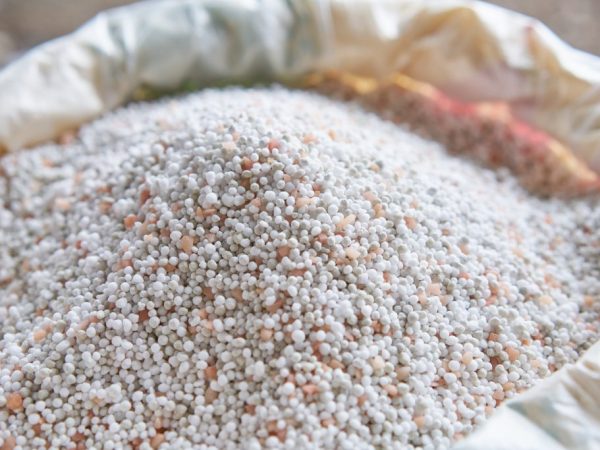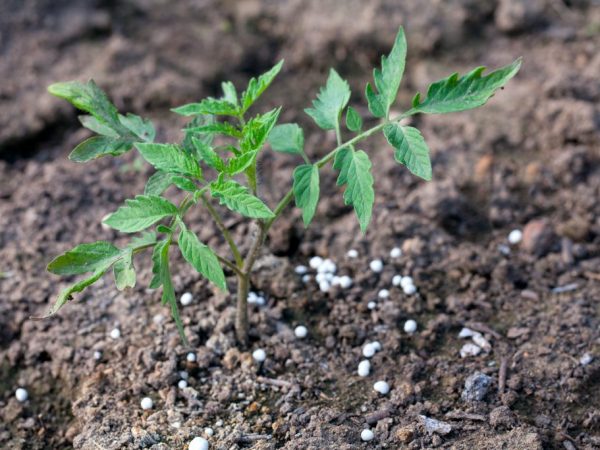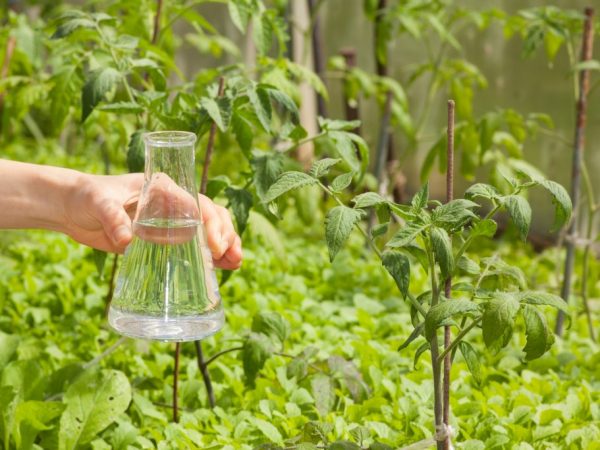Is feeding a tomato with saltpeter effective?
Any gardener knows that for a good harvest, any crop needs feeding, and the same goes for tomatoes. In order for the root system to develop well, so that the stem develops and the ovaries appear on time, the tomatoes need to be fed. Today we will talk about how to fertilize tomatoes with saltpeter, find out why many gardeners prefer this particular dressing and how to properly fertilize tomatoes with saltpeter.
- The benefits of saltpeter
- Characteristics and types of nitrate
- Ammonium nitrate grade B
- Ammonium nitrate with the addition of lime.
- Calcium nitrate
- Magnesium nitrate
- Potassium nitrate
- Sodium nitrate
- Advantage of Calcium Nitrate Fertilizer
- Fertilizer application for seedlings
- Fertilization with calcium nitrate after planting seedlings
- Top dressing with saltpeter during the formation of tomatoes
- Top dressing of tomatoes with ammonium nitrate
- The cost of saltpeter for a tomato

Top dressing tomato with saltpeter
The benefits of saltpeter
It should be said that feeding tomatoes with nitrate has a key effect on the full development of the plant and the appearance of fruits. However, in order for the fertilization to go not to harm, but to benefit, it is important to choose the right drug, correctly calculate the dose and make the fertilizer strictly according to the schedule. The peculiarity of feeding tomatoes is that it must be done absolutely at all stages of growth.
Many gardeners use organic matter for these purposes, that is, organic fertilizers. However, this choice will force you to spend too much time in the garden, as you have to wait until the compost matures, insist on droppings, sift ash, or separate the whey. Currently, experienced gardeners are advised to leave these methods in the distant past, since you can use minerals for feeding, which are simpler and more affordable to use.
Today, the most popular is tomato saltpeter. You can easily buy it in a shop specialized for gardeners, as well as on Internet sites. It is worth saying that the latter option is more preferable, since the fertilizer will arrive immediately at its destination, which will significantly save your time.
Characteristics and types of nitrate
It should be said right away that saltpeter is of several types, namely:
- Ammonia
- Calcium
- Sodium
- Potash and so on
In addition to the main subspecies, there is saltpeter, enriched with all kinds of trace elements that take into account the needs of a particular culture at different stages of growth. Despite the fact that saltpeter is a mineral, it contains nitrate, so it is important to follow the recommended norms so as not to deteriorate the quality of tomatoes. If we briefly describe the function of nitrate, then it can be described as an additional supply of the culture, in this case, the tomato, with nitrogen.
Let's describe each of the types of saltpeter:
Ammonium nitrate grade B
This type is very convenient to use in households that do not have a large area.Ideal for those crops that need nitrogen, that is, suitable for feeding tomatoes.
Ammonium nitrate with the addition of lime.
It is sold in the form of a powder, its composition is quite rich, it contains potassium, calcium and magnesium. However, one cannot but say that this fertilizer has drawbacks, due to the fact that calcium-ammonium nitrate contains fuel oil, which remains in the soil for a long time, poisoning crops. It is undesirable to fertilize and feed tomatoes with this type of nitrate.
Calcium nitrate

Calcium nitrate can be used dry
Calcium nitrate for tomatoes is sold both in dry and liquid form, and the latter has its own name - Ammonized calcium nitrate, of the advantages it is worth pointing out that the solution does not increase the acidity of the soil, as it usually happens during fertilization.
Magnesium nitrate
Magnesium saltpeter is often used to fertilize tomatoes and other vegetables and even legumes. Its function is that it increases photosynthesis, but the greatest efficiency can be achieved when combined with calcined nitrate.
Potassium nitrate
Potassium nitrate is used in cases where the plant or crop does not tolerate the chlorine content in the ground, and the tomato is also included in this category. With the help of potassium nitrate, it is possible to increase the immunity of the plant, as well as improve the ability of the root system to absorb moisture from the soil.
Sodium nitrate
As for sodium nitrate, it is enriched with sodium, which follows from the name of the fertilizer, as well as nitrogen. It is advisable to use it for tomatoes during the growing season of the crop. It is usually recommended to bring it into the ground in the autumn, preferably in saline soil. It is strictly forbidden to use it in greenhouse conditions, it will only harm the culture.
There is also such saltpeter, which cannot be used for tomatoes and cucumbers in any case, it is porous nitrate with ammonia for tomatoes. Generally speaking, this is not a fertilizer in general, it cannot be used also because it is explosive.
From the above information, we can conclude that the most suitable fertilizer for tomatoes is saltpeter with calcium nitrate, as well as ammonium nitrate, we will talk about them in more detail.
Advantage of Calcium Nitrate Fertilizer
The first thing that needs to be said about the advantages of the method of feeding with calcium nitrate:
- This dressing improves photosynthesis, which has a beneficial effect on the plant as a whole.
- Calcium nitrate improves and accelerates the growth of leaves, which allows you to speed up the harvest of tomatoes
- Timely fertilizing of tomatoes with calcium nitrate will affect the speedy ascent of seeds.
- After using it, the root system develops faster, the roots grow wider
- Tomato becomes less susceptible to damage from parasites and other pests
- With the help of top dressing with this saltpeter, the plant tolerates cold better, it is worth considering that tomatoes do not tolerate sharp temperature changes, which are quite often in Russia.
In addition, gardeners note that after harvesting the fruits retain their presentation longer, which lengthens the term and extends the shelf life. On average, the yield increases by 15-20%.
Despite the impressive list of advantages, there is one indisputable disadvantage, which is strictly necessary to be aware of before using calcium nitrate for tomatoes. If the rules for fertilizing the soil are not followed, usually under the condition of an excess of calcium nitrate, the root system can be seriously damaged, for this reason it is necessary to adhere to the instructions for use.
Fertilizer application for seedlings

Spraying with saltpeter has a beneficial effect on plant growth
This type of nitrate is ideal for feeding tomato seedlings with nitrate.A positive characteristic of this fertilizer is that it contains nitrogen, which is necessary for the early germination of seedling seeds, there is also calcium, the action of which is directed to the roots, and it also has a beneficial effect on the metabolism in the culture as a whole. If there is not enough calcium in the ground, then the culture bears fruit much worse, that is, the tomatoes ripen later.
Since tomatoes require complex fertilization, the most successful feeding method will be a solution of saltpeter. This method is also convenient because calcium nitrate can be easily dissolved in water for further watering or spraying. It is worth saying that calcium nitrate with calcium nitrate in no case can be combined with mineral fertilizers such as sulfur and phosphorus, this item is indicated in the instructions for the preparation.
The scheme of fertilizing tomatoes with nitrate indicates that the first treatment of tomatoes with calcium nitrate should occur at a time when the first leaves in the amount of 2-3 pieces are formed on the plant, they usually appear after 7-10 days after replanting. To fertilize the soil at the seedling stage, you need to dissolve 20 ml of the solution in ten liters of water. To enhance the effect, it is recommended to enrich the fertilizer with urea (10 grams are taken for 10 liters) and wood ash (100 grams are needed for 10 liters). The plant is treated with the resulting solution so as not to burn the leaves, that is, watering is carried out at the root. The introduction of dry fertilizer is not excluded, if you purchased calcium nitrate in powder form, then exactly 20 grams of the drug must be added to each tomato hole.
Fertilization with calcium nitrate after planting seedlings
After the tomato or cucumber seedlings are placed in greenhouses, the soil should be fertilized by spraying with mineralized fat. Here you must strictly follow the instructions for the drug so as not to cause irreparable harm to the culture. If you exceed the recommended dosage, there is a risk that the seedlings will die.
The instructions say that to spray a tomato with calcium nitrate, you will need one percent calcium powder, that is, you need to dissolve 100 grams of dry saltpeter in ten liters of water for further spraying or to water the plant. This treatment will help protect the tomato from parasite infestation (slugs, mites and apical rot).
It is worth clarifying that in greenhouse cultivation, which prevails in Russia, it is recommended to use nitrogen-containing fertilizers before flowering, this has a positive effect on the yield of the plant. To maximize the effect of the application, it is worth making sure that the drug is applied evenly, covering the entire green area, this stage is called foliar feeding of tomatoes with calcium nitrate.
The first treatment is carried out on the tenth to twelfth day after planting, after which it is repeated every 1-2 weeks of days until the ovaries appear. Immediately after this point, this treatment is stopped, since nitrates tend to accumulate, which can become a danger to human health.
Top dressing with saltpeter during the formation of tomatoes
Calcium nitrate, contained in the described nitrate, is necessary in order for a good ovary to form. To prepare a solution for feeding tomatoes with calcium nitrate at this stage, you will need the following ingredients:
- 10 liters of water
- Liquid manure - half a liter
- Calcium nitrate dry powder - 20 grams

Calcium nitrate promotes ovary formation
This stage is especially important for those soils that are classified as heavy; after cultivation, oxygen penetrates better into the ground, which improves the nutrition of the roots of the vegetable. If there is not enough nitrogen, you can observe the following picture - the leaves become thin, the flowers fall off, the fruits do not set well, and the tomatoes themselves are small and look unattractive.In addition, there is a clear sign of a lack of nitrogen, which speaks eloquently about a lack of nitrogen, this is the red color of the leaves. If you notice such a sign, you should immediately carry out an emergency treatment, pour the plant with a solution of nitrate, having previously dissolved 10 grams of the drug in 10 liters of water.
Speaking of planned processing, it will require half a liter of nitrate solution for each tomato bush. It is worth saying that even a one-time fertilization will help the vegetables stay intact and fresh.
It is worth saying that here it is also important not to overfeed the vegetable, since the plant can react to such a mistake by the death of the bush. Usually, the process begins with overgrowth of greens, and then the existing fruits crack. If we talk about errors, then it is better to underfeed a tomato than to do it in excess of the norm.
Top dressing of tomatoes with ammonium nitrate
In addition to feeding with calcium nitrate, ammonium nitrate is often used. In order to prepare a solution for the soil, you will need 10 grams of dry fertilizer, as well as 2 tbsp. ash, all this is dissolved in five liters of water, this amount will be needed for one square meter of land. It is worth saying that such treatment should be periodic, it should be repeated every two weeks, after which be sure to make warm watering, this will help to assimilate all useful substances. As it was written earlier in the description of the calcium nitrate preparation, watering must be done strictly at the root, so as not to damage the leaves, the exception is foliar watering.
The composition of ammonium nitrate for tomatoes also assumes the presence of nitrogen, it is at least 30% in the fertilizer. It is recommended to use ammonium nitrate only at the beginning, that is, at the seedling stage. Often, to improve the effect, potassium is added to the solution (its amount is equal to the content of nitrate itself), as well as magnesium (about 20 grams per 10 liters of water). It is worth saying that the last component helps to increase the fruiting of tomatoes, contributes to the fact that the fruits are dense, juicy.
The cost of saltpeter for a tomato
Calcium nitrate is an affordable fertilizer, its price allows people with different incomes and farm sizes to use it. On average, its price is about 50 rubles per kilogram when it comes to powdered fertilizer.
It should also be said that it is used very sparingly. One hundred square meters will need about one kilogram of fertilizer, since the mineral nutrition rate is about 20 grams per square meter of the garden.


